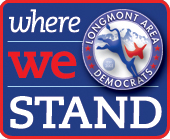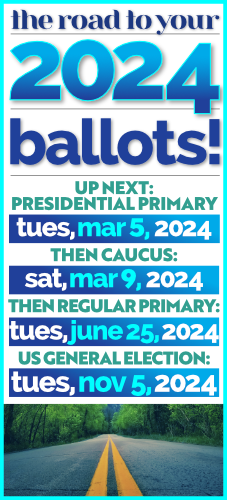CANDIDATES:
Residents who live within the boundaries of Longmont’s 3 wards (Ward map here) will vote for the Mayoral, Ward 2 Representative and 2 At-Large Representative seats for this election. Longmont Area Democrats does not officially endorse candidates in non partisan races, but our mission is to educate folks around all election issues and candidates, encouraging local Democrats to attend our Candidate Forum (held on October 4) and other local candidate forums, look at candidate literature, check out websites, attend city council meetings and talk with the candidates themselves — framing your decision around whether candidates represent progressive values. As the great Democrat and Speaker of the House Tip O’Neill said, “all politics is local.”
Sustainable Resilient Longmont Candidate Forum here.
Latino Task Force of Boulder County Candidate Forum:
Longmont Observer Meet the 2017 Candidates, here.
Longmont Chamber of Commerce Candidate Forum, here.
Boulder Weekly 2017 Voter Guide, here.
BALLOT ISSUES:
We analyzed 3 issues that will be on your ballot besides the city council races — we hope you find this helpful. We took positions on two of the issues (2H and 2I), but also pose the question for all three as to why developers in our town have not been called to fairly contribute in these areas, instead of imposing a tax on residents? (a recurring theme) We also discovered that the Water Storage Bond (2J), like all Colorado water law, is complicated and has lots of moving parts. LAD is not taking a position on 2J, but listing concerns, as well as what might be considered positive aspects, to aid you in your voting decision. We have consulted with a number of knowledgeable people on this issue, including a water engineer from the city staff. You’ll find the extensive analysis below.
2H: PUBLIC SAFETY TAX
• The increased money from this tax will keep the city from having to use money from human services and other city priorities. When push comes to shove human services often lose out.
• This tax helps citizens right now through increased fire, police and medical services.
• Generally we regard sales taxes as regressive. However approximately 2.5 cents out of $10 is a small increase.
Question: Why is the city using general funds as incentive to bring in more development (like the mall) and not using this money for public safety?
(The Longmont Area Democrats Board voted yes on 2H)
2I: MARIJUANA TAX
• An additional tax on marijuana could help pay for any extra public safety costs that might arise from marijuana dispensaries in the city.
• Half (1.5% of the 3% tax) will go to an affordable housing fund. Only 4 marijuana retail stores will be approved so the fund is a small incentive. If the tax is raised in the future the affordable housing portion will not change.
• Only people who buy marijuana at retail stores will pay the tax.
Question: Why not have development cover an affordable housing fund itself instead of using a marijuana tax?
(The Longmont Area Democrats Board voted yes on 2I)
2J: WATER STORAGE BOND
Points to Consider:
• Windy Gap is a water storage project and manages water that is already being transported. We are paying for our share of construction on a new reservoir, called Chimney Hollow.
• The city has been saving money to pay for the Windy Gap water storage in cash at the 6000 acre feet level but Longmont would still need to raise water rates by 9% in 2018 and 2019 due to the need for work on the water treatment plant and new transmission and collection pipelines (already been raised in 2017). The water storage at 10,000acre ft. (an amount beyond the city water engineers’ recommendation) will require another 5% increase in water rates over the next two years and rates would stay at that level for the life of the bond. (20 years) The 10,000 acre foot level requires a bond issue vote. If it passes water rates would be on average $24 per year more (water engineer’s estimate).
• To understand the water rate increases keep in mind the infrastructure work must be done. The 10,000acre feet is beyond the 9% rate hikes for infrastructure.
• Again, the city staff has been saving money to pay for the Windy Gap water storage in cash at the 6000 acre feet level.
• Any utility increase adds up for families who are working hard at minimum wage.
• Some on the Council and on the Water Board feel this amount of water storage will be “insurance” against a drought.
• The best “insurance” could be a well-developed conservation program for the city (which is missing in the discussion over this bond.) A strong conservation plan could go a long way in supporting the Colorado River and maintaining water supply for Longmont.
• More water storage virtually insures more growth. Although Longmont is close to build out (estimate within 10-15%) More growth beyond that is probable in commercial and mixed use development. Mixed use gentrification requires more water. Note again this is paying for water storage that allows for more growth. (Once again, this highlights a concern that residents are being asked to pay more but is development paying its fair share?)
• The 6000 acre feet suggested by the city water engineers was based on a needs study from 2008-2012 to provide enough water for a population of 120,000 residents and businesses.
• Any surplus water stored (if the bond issue passed) could be used to increase the flow of water in the St. Vrain especially since that river has fish populations that are endangered. This would be up to residents to encourage council to do. In other words not a given.
• Also, surplus water would probably be leased to farmers around the city. They would have to pay for it. (Again depends on citizen input and the ability to influence the council)
• The Windy Gap pumping project includes a decree that includes volume and flow rate limits to protect the river. There is also an agreement included to allow no pumping in late summer to keep the Colorado River water cooler for fish.
• Trout Unlimited and the Division of Wildlife are ok with the plan.
• Consider this sentence from the Trout Unlimited press release: “In our Filling the Gap report, we said that WGFP, (Windy Gap Firming Project) if done right, had the potential to be part of a smart supply portfolio for Colorado’s Front Range, along with stronger conservation and reuse programs and better agriculture-urban water sharing strategies…” (Read full Trout Unlimited press release here.)
• Longmont has an ordinance that states no leasing of water to oil and gas and also to other political entities in what is called a”Water Supply Review Zone” that is Hwy #66 to Hwy #52 (North-South) and County Line Road #1 to I-25 (West to East). But ordinances can be changed.
• The City can lease to Platte River Power Authority ( PRPA.) Their use is for water at their Rawhide Power Plant, north of Fort Collins. The water would first go through the Fort Collins system, then be pumped to the power plant as effluent from the Fort Collins Wastewater Treatment plant. Rawhide is a coal fired plant and not a hydro-power plant, although the water as it travels through the system does generate considerable hydro-power resources.
• If the bond does not pass then other municipalities in the project will pick up the 4000 acre feet surplus water quickly, according to the water engineer. (And they may need the water.) The advisory water board is speculating that Longmont will need 10,000 acre feet of water in the future. But the residents have to pay for that now.
• If the bond passes Longmont will control the use of the extra 4000 acre feet.
(The Longmont Area Democrats Board took no position on 2J)




















